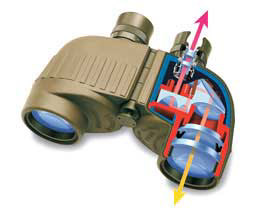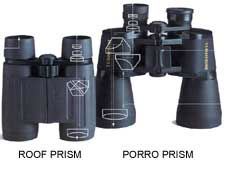On this page we have compiled a list of the key points you need to know when choosing a binocular. For more details, visit the How to Buy a Binocular guide on OpticsPlanet.com.
Quick Chart Buying Guide
What are Binoculars and how do they work?
Binoculars, in its simplest definition, are magnification instruments that are made up of two telescopes mounted on a metal or plastic frame so that a viewer can view images as if they were much closer.
This process occurs by utilizing curved glass lenses and multiple lenses within the frame to magnify the subject each time it passes through to the next lens. The downside to this is that each time this occurs some light is lost. More often than not prisms are utilized in the process as well which bend and reflect the light entering the objective lens.
Many binoculars today utilize prisms which bend the light as it enters the objective lens and helps to magnify the image as it passes through the frame. The result is a binocular that can be made smaller and more powerful.
Focusing Your Binoculars. Most Binoculars have a center focus wheel and a right eye diopter adjustment near the eyepiece to account for the small difference in the strength of each eye. While looking through the binoculars at a stationary target about 30-50 feet away, close your right eye and focus using the center wheel until the image is clear for your left eye. Once clear, close your left eye and open your right eye. Looking at the same target, adjust the right side diopter ONLY on the right eyepiece (DO NOT use the center focus wheel) until the image is clear. When the image is clear, you can now open both eyes and use ONLY the center focus wheel to make adjustments. Your right side diopter setting is now fixed to your preferences. No further adjustment will be necessary except for the center focus wheel. PLEASE NOTE that some binoculars do employ different focusing mechanisms so please read the user manual included in your purchase.
Eyecups are designed to exclude any additional stray light that may interfere with the eyepieces during use. Some models use rubber eyepieces that fold down while some may use twist up/down or pull up/down. Generally eyeglass wearers will keep the eyecups down which will bring your eyes closer to the lenses improving your view.
What do the Numbers mean?
Binoculars are often specified by a set of numbers such as 7×35 or 8×40, the first number indicates the strength of magnification (how many times closer the subject is to you, 5 times closer, 7 times closer, 10 times closer) and the second number is the size of the objective lens measured in millimeters going across the lens. The size of the objective lens will determine how much light the binocular can obtain for effective viewing. The higher the number, the larger the lens; in effect allowing more light to pass through thereby projecting a brighter image and viewing experience. However, binoculars with smaller lenses are more compact and portable.
Zoom Binoculars work on the same principle as regular binoculars except that the power can be adjusted to give you varying ranges of magnification. For example, a binocular that is listed as 10-22x50mm means the zoom portion is capable of viewing at 10x power minimum and can be adjusted up to 22x power and the 50mm would be the objective lens size ( the larger lenses at the opposite end of the binocular ). When considering zoom binoculars remember that a larger objective lens would fare better giving you the greatest amount of light gathering, however they will be bigger and heavier.
Binoculars are built around a frame that houses the two telescopes and is generally hinged to allow for adjustment for each individual viewer.Some binoculars are perma focus and never need adjustment and can be used instantly, while others have a focusing wheel in the center to allow for manual focusing and a greater degree of fine tuning for sharper images. Some models also offer focusing systems on each eye piece and once adjusted they are set for that viewer. Separate focusing of each eyepiece (known as Diopter Control) is also available in some types of binoculars, which allows for additional precision.
Which Binoculars are right for me?
Remember one thing, the higher the magnification, the steadier your arms need to be. If you consider anything over 12x magnification you may want to invest in a stand or tripod that will hold the binoculars for you. Generally speaking though, 7x – 12x magnification should be fine for wide area viewing and hand holding.
The most important things to consider are:
1. What is your Budget? 2. What is the primary purpose of using the binoculars? 3. Who will be using the binoculars and are there any special requirements (Eyeglass wearers, poor vision, young person or old)?
Once these answers become evident, it becomes much easier to narrow down the particular models to 2 or 3, and then the choice becomes one of personal preference.
Here is an example of a question asked by one of our shoppers and the way we narrowed it down, completed the sale AND received positive feedback for shipping the correct pair of binoculars: “I need a compact pair of binoculars suitable for concerts and sporting events under $100”
In this particular case the first place I would start looking in is the compact section with a power range of no more than 7x magnification. Higher power makes it harder to keep up with the action on the field, and you really don’t want to miss all the action by being focused on just one player. The other recommendation was to go with a smaller sized zoom binocular which will offer you the capability of zooming in when you want to (or if you are really sitting in the cheap seats). However, the price range was slightly higher than the recommended amount but by far a much more versatile binocular. In this case, we sold the zoom binoculars and received a great response from the buyer.
Eye relief, which is the distance a binocular can be held away from the eye while still presenting the full field of view, should also be considered.” Extended or long eye relief reduces eyestrain and is ideal for eyeglass wearers. Consider binoculars that have over 16mm of eye relief for eyeglass wearers.

What does “Exit Pupil” mean?
Exit Pupil stands for the measurement of the circle of light that appears when you look through the binoculars while holding them at a short distance away from your eyes. The exit pupil relates to how well a binocular will perform in dim light. If you hold binoculars away from your eyes and up to the light, you will see a bright circle in the center of the eyepiece. The exact size can be measured by dividing the objective lens by the magnification of the binoculars. A 10×50, for example, would have an exit pupil of 5 and a 7 x 42 binocular would have an exit pupil of 6 millimeters.
As a guide, you should ensure that your binoculars have a similar size exit pupil to your own pupils. During low light conditions, our eyes’ pupils open to about 5 to 7mm wide to allow more light to pass to the pupil. So if you intend on using the binoculars during low light conditions or at night, choose a pair with a similar value exit pupil. In bright conditions, the pupils contract to about 2 or 3 millimeters and in such conditions, the extra transmitted light isn’t needed.
What lens size should I buy?
The lens sizes are measured in millimeters (mm). Remember this is the second number in the equation. The human eye will adjust based on what you are viewing and the surrounding light conditions but the general rule of thumb is 5 times the magnification level. So if you are looking at a pair of binoculars that have 7x magnification, then you might want to consider a lens size of 35mm or a pair of binoculars listed as 7×35. A greater amount of light will enter through a larger lens size. This needs to be considered if you plan to use the binoculars for low light conditions or night viewing.
What is a BAK-4 prism?

Prisms are located inside binoculars that act like mirrors. It is a reflective coating on glass that bends and refracts light to bring the subjects you are looking at to your eyes. The image that passes through the binocular lenses is upside down due to the function of the lenses. The prisms are the optical pieces of glass that correct this and invert the image back to its normal position. The BAK-4 prism is constructed from high quality glass and produces sharp images and good edge to edge sharpness. Generally, higher quality binoculars will use BAK-4 prisms in the construction process. Phase coated prisms take it one step further. The coating process enhances the resolution and contrast of images coming through the binocular and are generally only applied on more expensive binoculars.
Roof Prism System In roof prism binoculars the prisms overlap closely, allowing the objective lenses to line up directly with the eyepiece. The result is a slim, streamlined shape in which the lenses and prisms that magnify and correct the image are in a straight line.
Porro Prism System In porro prism binoculars the objective or front lens is offset from the eyepiece. Porro prism binoculars provide greater depth perception and generally offer a wider field of view.
What does “Field of View” mean?
Field-of-view is the size of an area that can be viewed using the binoculars. For example, if two people were standing 1000 yards away from you with one to your left and one to your right, and the distance between the two people was 350 feet, then your field-of-view would be 350ft at 1000 yards while looking through the binoculars. Generally, higher powered binoculars give you a smaller field-of-view and the opposite is true for lower powered binoculars. Field-of-view may also be expressed in degrees, which is called the angular field. To convert angular field to the more practical linear field, multiply the angular field by 52.5.
What are lens coatings?
Ever look at a lake with the sun shining on it? Did you notice the glare coming off the water? Well, that’s what happens to binoculars that don’t have coated lenses. The lens coatings help to remove any glare and allow as much light as possible to enter the optics. The more expensive brands will have multiple coatings on ALL the lenses which will help produce the brightest and clearest images possible.
There are 4 levels of coating:
Coated: A single layer on at least one lens. Fully-Coated: A single layer on all air-to-glass surfaces. Multi-Coated: Multiple layers on at least one lens. Fully Multi-Coated: Multiple layers on all air-to-glass surfaces.













